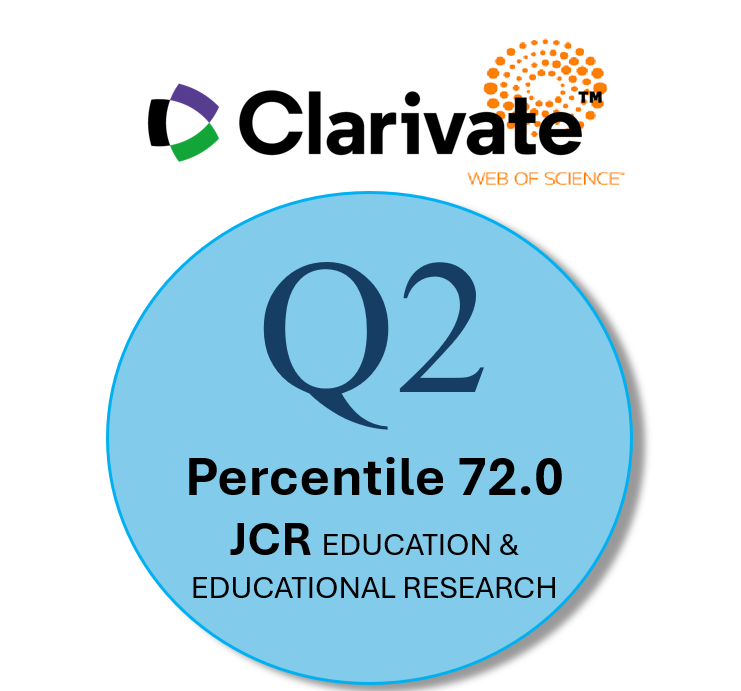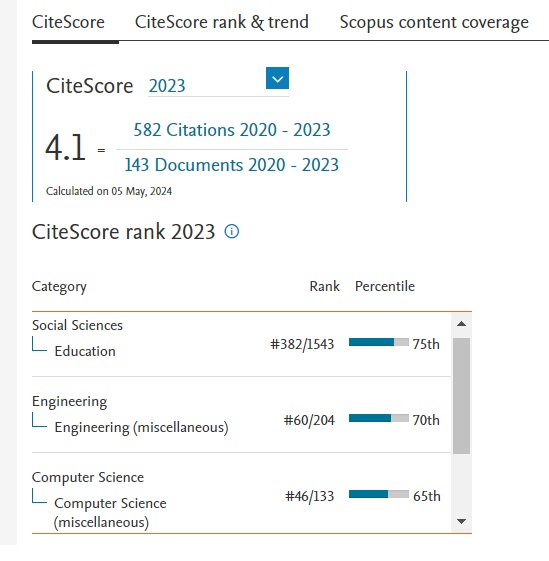Espacios de afinidad docente en Twitter
El caso del hashtag #Claustrovirtual
Agencias de apoyo
- Esta publicación es parte del proyecto de I D i PGC2018-096474-B-I00, financiado por MCIN/ AEI/10.13039/501100011033/
Resumen
Twitter se ha constituido en un espacio de encuentro y afinidad de docentes que permite la generación de comunidades de aprendizaje informal en línea. A través del análisis de un total de 22.897 tuits que incluyeron el hashtag #Claustrovirtual distribuidos entre los meses de marzo de 2020 a enero de 2022 hemos analizado la frecuencia y distribución temporal de publicación. Mediante el programa Graphext hemos realizado un análisis de redes sociales, concretando el grado de centralidad y centralidad de intermediación, lo que nos ha permitido conocer los roles de liderazgo que asumen los docentes más activos en el hashtag. A través del análisis realizado hemos identificado cuatro roles en las redes sociales: emisores, transmisores, difusores e intermediadores. Para analizar de manera descriptiva por qué y para qué utilizan los docentes el #Claustrovirtual diseñamos un instrumento compuesto por 8 dimensiones que fue respondido por 81 docentes con un alto nivel de participación en el #Claustrovirtual. Entre los resultados obtenidos, encontramos que estos docentes hacen uso de hashtag en sus publicaciones tanto para localizar y recurrir a docentes con más experiencia, así como para plantear dudas y preguntas a la comunidad o pedir apoyo a la misma.
Descargas
-
Resumen1327
-
PDF1283
Citas
Blondel, V.D., Guillaume, J.L., Lambiotte, R., & Lefebvre, E. (2008). Fast unfolding of communities in large networks. Journal of Statistical Mechanics: Theory and Experiment, 2008(10). https://doi.org/10.1088/1742- 5468/2008/10/p10008
Britt, V. G., & Paulus, T. (2016). “Beyond the Four Walls of My Building”: A Case Study of #Edchat as a Community of Practice. American Journal of Distance Education, 30(1), 48–59. https://doi.org/10.1080/08923647.2016.1119609
Burt, R. S. (1999). The social capital of opinion leaders. The Annals of the American Academy of Political and Social Science, 566(1), 37-54.
Carpenter, J. P., & Krutka, D. G. (2014). How and why educators use Twitter: A survey of the field. Journal of research on technology in education, 46(4), 414-434.
Carpenter, J. P., Kimmons, R., Short, C. R., Clements, K., & Staples, M. E. (2019). Teacher identity and crossing the professional-personal divide on twitter. Teaching and Teacher Education, 81, 1–12. https://doi.org/https://doi.org/10.1016/j.tate.2019.01.011
Carpenter, J. P., Morrison, S. A., Craft, M., & Lee, M. (2020). How and why are educators using Instagram?. Teaching and teacher education, 96, 103149.
Carpenter, J., Tani, T., Morrison, S., & Keane, J. (2020). Exploring the landscape of educator professional activity on Twitter: An analysis of 16 education-related Twitter hashtags. Professional Development in Education, 1-22.
Colina, C. L., Roldán, P. L., Bolíbar, M., & Muntanyola, D. (2013). La centralidad en las redes sociales: medición, correlación y aplicación. Metodología de Encuestas, 15, 77-97.
De Rijdt, C., Stes, A., Van Der Vleuten, C., & Dochy, F. (2013).
Influencing variables and moderators of transfer of learning to the workplace within the area of staff development in higher education: Research review. Educational Research Review, 8, 48-74.
del Fresno García, M., Daly, A. J., & Sánchez-Cabezudo, S. S. (2016). Identificando a los nuevos influyentes en tiempos de Internet: medios sociales y análisis de redes sociales/identifying the new influencers in the Internet Era: social media and social network analysis. Reis: Revista Española De Investigaciones Sociológicas, 23-42.
Fox, A. R., & Wilson, E. G. (2015). Networking and the development of professionals: Beginning teachers building social capital. Teaching and Teacher Education, 47, 93-107.
Gao, F y Li, L (2017). Examining a one-hour synchronous chat in a microblogging-based professional development community. British Journal of Educational Technology, 48 (2), 332-347.
García-Martín, J., & García-Sánchez, J. N. (2015). Use of facebook, tuenti, twitter and myspace among young Spanish people. Behaviour & Information Technology, 34(7), 685-703.
Gee, J. P. (2005). Semiotic social spaces and affinity spaces. Beyond communities of practice language power and social context, 214232.
Gee, J. P. (2017). Affinity Spaces and 21st Century Learning. Educational Technology, 57(2), 27–31. http://www.jstor.org/stable/44430520
Gilbert, S. (2016). Learning in a Twitter-based community of practice: an exploration of knowledge exchange as a motivation for participation in #hcsmca. Information, Communication & Society, 19(9), 1214–1232. https://doi.org/10.1080/1369118X.2016.1186715
Greenhalgh, S. P., & Koehler, M. J. (2017). 28 days later: Twitter hashtags as “just in time” teacher professional development. TechTrends, 61(3), 273-281.
Greenhalgh, S. P., Willet, K. B. S., Rosenberg, J. M., & Koehler, M. J. (2018). Tweet, and we shall find: Using digital methods to locate participants in educational hashtags. TechTrends, 62(5), 501-508.
Greenhalgh, S. P., Willet, K. B. S., Rosenberg, J. M., & Koehler, M. J. (2018). Tweet, and we shall find: Using digital methods to locate participants in educational hashtags. TechTrends, 62(5), 501-508.
Greenhow, C., & Askari, E. (2017). Learning and teaching with social network sites: A decade of research in K-12 related education. Education and Information Technologies, 22(2), 623–645. https://doi.org/10.1007/s10639-015-9446-9
Hart, J. E., & Steinbrecher, T. (2011). OMG! Exploring and learning from teachers' personal and professional uses of Facebook. Action in Teacher Education, 33(4), 320-328.
Higueras-Rodríguez, L., Medina-García, M., & Pegalajar-Palomino, M. D. (2020). Use of Twitter as an Educational Resource. Analysis of Concepts of Active and Trainee Teachers. In Education Sciences. 10, (8). https://doi.org/10.3390/educsci10080200
Holmes, K., Preston, G., Shaw, K., & Buchanan, R. (2013). ‘Follow’ Me: Networked Professional Learning for Teachers. Australian Journal of Teacher Education, 38(12).
Hur, J. W., & Brush, T. A. (2009). Teacher participation in online communities: Why do teachers want to participate in self-generated online communities of K-12 teachers? Journal of Research on Technology in Education, 41(3), 279–303. doi:10.1080/15391523.2009.10782532
Jones, W. M., & Dexter, S. (2014). How teachers learn: The roles of formal, informal, and independent learning. Educational Technology Research and Development, 62(3), 367-384.
Junco, R., Heiberger, G., & Loken, E. (2011). The effect of Twitter on college student engagement and grades. Journal of computer assisted learning, 27(2), 119-132.
Koseoglu, S., & Bozkurt, A. (2018). # DigPed Narratives in Education: Critical Perspectives on Power and Pedagogy. Online Learning, 22(3), 157-174.
Koutropoulos, A., Abajian, S. J., deWaard, I., Hogue, R. H., Keskin, N. O., & Rodriguez, C. O. (2014). What tweets tell us about MOOC participation. International Journal of Emerging Technologies in Learning (iJET), 9(1), 8–21.
Krutka, D. G., Asino, T. I., & Haselwood, S. (2018). Eight Lessons on networked teacher activism from# OklaEd and the# OklaEdWalkout. Contemporary Issues in Technology and Teacher Education, 18(2), 379-391.
Kyndt, E., Gijbels, D., Grosemans, I., & Donche, V. (2016). Teachers’ everyday professional development: Mapping informal learning activities, antecedents, and learning outcomes. Review of educational research, 86(4), 1111-1150.
Lantz-Andersson, A., Lundin, M., & Selwyn, N. (2018). Twenty years of online teacher communities: A systematic review of formally-organized and informally-developed professional learning groups. Teaching and Teacher Education, 75, 302–315. https://doi.org/https://doi.org/10.1016/j.tate.2018.07.008
Li, S., Zheng, J., & Zheng, Y. (2020). Towards a new approach to managing teacher online learning: Learning communities as activity systems. The Social Science Journal, 1–13. https://doi.org/10.1016/j.soscij.2019.04.008
Loughran, J., & Hamilton, M. L. (2016). Developing an understanding of teacher education. In International handbook of teacher education (pp. 3-22). Springer, Singapore.
Luo, Z., Osborne, M., Tang, J., & Wang, T. (2013, July). Who will retweet me? Finding retweeters in Twitter. In Proceedings of the 36th international ACM SIGIR conference on Research and development in information retrieval (pp. 869-872).
Luo, T., Freeman, C., & Stefaniak, J. (2020). “Like, comment, and share”—professional development through social media in higher education: A systematic review. Educational Technology Research and Development, 68(4), 1659-1683. https://doi.org/10.1016/j.pubrev.2017.02.006
Macià, M., & García, I. (2016). Informal online communities and networks as a source of teacher professional development: A review. Teaching and Teacher Education, 55, 291–307. https://doi.org/https://doi.org/10.1016/j.tate.2016.01.021McCulloh, I., Armstrong, H., & Johnson, A. (2013). Social network analysis with applications. John Wiley & Sons, Inc
Nochumson, T. (2018). An investigation of elementary schoolteachers’ use of twitter for their professional learning. Columbia University.
Nochumson, T. C. (2020). Elementary schoolteachers’ use of Twitter: exploring the implications of learning through online social media. Professional Development in Education, 46(2), 306–323. https://doi.org/10.1080/19415257.2019.1585382
Prestridge, S. (2019). Categorising teachers’ use of social media for their professional learning: A self-generating professional learning paradigm. Computers & Education, 129, 143-158.
Rehm, M., & Notten, A. (2016). Twitter as an informal learning space for teachers!? The role of social capital in Twitter conversations among teachers. Teaching and Teacher Education, 60, 215-223.
Rosell-Aguilar, F. (2018). Twitter: A professional development and community of practice tool for teachers. Journal of Interactive Media in Education, 1.
Rosenberg, J. M., Greenhalgh, S. P., Koehler, M. J., Hamilton, E. R., & Akcaoglu, M. (2016). An investigation of state educational Twitter hashtags (SETHs) as affinity spaces. E-learning and Digital Media, 13(1-2), 24-44.
Schulten, K. (30 de septiembre de 2011). Teachers teaching teachers, on Twitter: Q. and A. on ″Edchats″. The New York Times. https://learning.blogs.nytimes.com/2011/09/30/teachers-teaching-teachers-on-twitter-q-and-a-on-edchats/
Shea, D., Alemu, D. S., & Visser, M. J. (2020). A social network study of transformational teacher influence. Teacher Development, 24(5), 603–625. https://doi.org/10.1080/13664530.2020.1818614
Sihag, V.K., Anand, A., Tomar, R., Chandra, J., Tiwari, R., Dumka, A., & Poonia, A.S. (2014). Detecting community structure based on traffic at node in networks. [Conference] 2014 IEEE Students’ Conference on Electrical, Electronics and Computer Science, Bhopal, India. https://doi.org/10.1109/SCEECS.2014.6804502
Staudt Willet, K. B. (2019). Revisiting How and Why Educators Use Twitter: Tweet Types and Purposes in #Edchat. Journal of Research on Technology in Education, 51(3), 273–289. https://doi.org/10.1080/15391523.2019.1611507
Tang, Y y Hew, K.F. (2017). Using Twitter for education: Beneficial o simply a waste of time?. Computers & Education, 106, 97-118.
Tess, P. A. (2013). The role of social media in higher education classes (real and virtual)–A literature review. Computers in human behavior, 29(5), A60-A68.
Theocharis, Y., Lowe, W., Van Deth, J. W., & García-Albacete, G. (2015). Using Twitter to mobilize protest action: online mobilization patterns and action repertoires in the Occupy Wall Street, Indignados, and Aganaktismenoi movements. Information, Communication & Society, 18(2), 202-220. 10.1080/1369118X.2014.948035
Van den Beemt, A., Buijs, J., & Van der Aalst, W. (2018). Analysing structured learning behaviour in massive open online courses (MOOCs): an approach based on process mining and clustering. International Review of Research in Open and Distributed Learning, 19(5).
Wang, Y., & Fikis, D. J. (2019). Common Core State Standards on Twitter: Public Sentiment and Opinion Leaders. Educational Policy, 33(4), 650–683. https://doi.org/10.1177/0895904817723739
Veletsianos, G. (2017). Three cases of hashtags used as learning and professional development environments. TechTrends, 61(3), 284-292.
Wenger, E. (2000). Communities of Practice and Social Learning Systems. Organization, 7(2), 225–246. https://doi.org/10.1177/135050840072002
Wideen, M., Mayer-Smith, J., & Moon, B. (1998). A critical analysis of the research on learning to teach: Making the case for an ecological perspective on inquiry. Review of educational research, 68(2), 130-178.
Derechos de autor 2022 Revista de Educación a Distancia (RED)

Esta obra está bajo una licencia internacional Creative Commons Atribución-NoComercial 4.0.
Las obras que se publican en esta revista están sujetas a los siguientes términos:
1. El Servicio de Publicaciones de la Universidad de Murcia (la editorial) conserva los derechos patrimoniales (copyright) de las obras publicadas, y favorece y permite la reutilización de las mismas bajo la licencia de uso indicada en el punto 2.
2. Las obras se publican en la edición electrónica de la revista bajo una licencia Creative Commons Reconocimiento-NoComercial-SinObraDerivada 3.0 España (texto legal). Se pueden copiar, usar, difundir, transmitir y exponer públicamente, siempre que: i) se cite la autoría y la fuente original de su publicación (revista, editorial y URL de la obra); ii) no se usen para fines comerciales; iii) se mencione la existencia y especificaciones de esta licencia de uso.
3. Condiciones de auto-archivo. Se permite y se anima a los autores a difundir electrónicamente las versiones pre-print (versión antes de ser evaluada) y/o post-print (versión evaluada y aceptada para su publicación) de sus obras antes de su publicación, ya que favorece su circulación y difusión más temprana y con ello un posible aumento en su citación y alcance entre la comunidad académica. Color RoMEO: verde.














